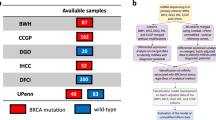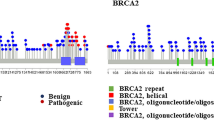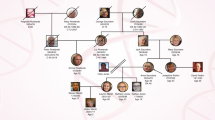Abstract
Although a wide number of breast cancer susceptibility alleles associated with various levels of risk have been identified to date, about 50% of the heritability is still missing. Although the major BRCA1 and BRCA2 genes are being extensively screened for truncating and missense variants in breast and/or ovarian cancer families, potential regulatory variants affecting their expression remain largely unexplored. In an attempt to identify such variants, we focused our attention on gene regulation mediated by microRNAs (miRs). We screened two genes, MIR146A and MIR146B, producing miR-146a and miR-146b-5p, respectively, that regulate BRCA1, and the 3′- untranslated regions (3′-UTRs) of BRCA1 and BRCA2 in the GENESIS French national case/control study (BRCA1- and BRCA2-negative breast cancer cases with at least one sister with breast cancer and matched controls). We identified one rare variant in MIR146A, four in MIR146B, five in BRCA1 3′-UTR and one in BRCA2 3′-UTR in 716 index cases and 619 controls. Among these 11 rare variants, 7 were identified each in 1 index case. None of the three relevant MIR146A/MIR146B variants affected the pre-miR sequences. The potential causality of the four relevant BRCA1/BRCA2 3′-UTRs variants was evaluated with luciferase reporter assays and co-segregation studies, as well as with bioinformatics analyses to predict miRs-binding sites, RNA secondary structures and RNA accessibility. This is the first study to report the screening of miR genes and of BRCA2 3′-UTR in a large series of familial breast cancer cases. None of the variant identified in this study gave convincing evidence of potential pathogenicity.
Similar content being viewed by others
Log in or create a free account to read this content
Gain free access to this article, as well as selected content from this journal and more on nature.com
or
Accession codes
References
Clop A, Marcq F, Takeda H et al: A mutation creating a potential illegitimate microRNA target site in the myostatin gene affects muscularity in sheep. Nat Genet 2006; 38: 813–818.
Wojcicka A, de la Chapelle A, Jazdzewski K : MicroRNA-related sequence variations in human cancers. Hum Genet 2014; 133: 463–469.
Chen X, Paranjape T, Stahlhut C et al: Targeted resequencing of the microRNAome and 3'UTRome reveals functional germline DNA variants with altered prevalence in epithelial ovarian cancer. Oncogene 2015; 34: 2125–2137.
Feng J, Sun G, Yan J et al: Evidence for X-chromosomal schizophrenia associated with microRNA alterations. PLoS ONE 2009; 4: e6121.
Blahna MT, Hata A : Regulation of miRNA biogenesis as an integrated component of growth factor signaling. Curr Opin Cell Biol 2013; 25: 233–240.
Adams BD, Kasinski AL, Slack FJ : Aberrant regulation and function of microRNAs in cancer. Curr Biol 2014; 24: R762–R776.
Mavaddat N, Antoniou AC, Easton DF, Garcia-Closas M : Genetic susceptibility to breast cancer. Mol Oncol 2010; 4: 174–191.
Economopoulou P, Dimitriadis G, Psyrri A : Beyond BRCA: new hereditary breast cancer susceptibility genes. Cancer Treat Rev 2015; 41: 1–8.
Michailidou K, Beesley J, Lindstrom S et al: Genome-wide association analysis of more than 120,000 individuals identifies 15 new susceptibility loci for breast cancer. Nat Genet 2015; 47: 373–380.
Meeks HD, Song H, Michailidou K et al: BRCA2 polymorphic stop codon K3326X and the risk of breast, prostate and ovarian cancers. J Natl Cancer Inst 2015; 108: djv315.
Giacomazzi J, Graudenz MS, Osorio CA et al: Prevalence of the TP53 p.R337H mutation in breast cancer patients in Brazil. PLoS ONE 2014; 9 (e99893).
Garcia AI, Buisson M, Bertrand P et al: Down-regulation of BRCA1 expression by miR-146a and miR-146b-5p in triple negative sporadic breast cancers. EMBO Mol Med 2011; 3: 279–290.
Kumaraswamy E, Wendt KL, Augustine LA et al: BRCA1 regulation of epidermal growth factor receptor (EGFR) expression in human breast cancer cells involves microRNA-146a and is critical for its tumor suppressor function. Oncogene 2014; 34: 4333–4346.
Taganov KD, Boldin MP, Chang KJ, Baltimore D : NF-kappaB-dependent induction of microRNA miR-146, an inhibitor targeted to signaling proteins of innate immune responses. Proc Natl Acad Sci USA 2006; 103: 12481–12486.
Sinilnikova OM, Dondon MG, Eon-Marchais S et al: A French national resource to study the missing heritability of breast cancer. BMC Cancer, (in press).
Lheureux S, Lambert B, Krieger S et al: Two novel variants in the 3'UTR of the BRCA1 gene in familial breast and/or ovarian cancer. Breast Cancer Res Treat 2011; 125: 885–891.
Abelson JF, Kwan KY, O'Roak BJ et al: Sequence variants in SLITRK1 are associated with Tourette's syndrome. Science 2005; 310: 317–320.
Dusl M, Senderek J, Muller JS et al: A 3′-UTR mutation creates a microRNA target site in the GFPT1 gene of patients with congenital myasthenic syndrome. Hum Mol Genet 2015; 24: 3418–3426.
Shen J, Ambrosone CB, DiCioccio RA, Odunsi K, Lele SB, Zhao H : A functional polymorphism in the miR-146a gene and age of familial breast/ovarian cancer diagnosis. Carcinogenesis 2008; 29: 1963–1966.
Nikolic ZZ, Savic Pavicevic DL, Vucic NL, Romac SP, Brajuskovic GN : Association between a genetic variant in the hsa-miR-146a gene and cancer risk: an updated meta-analysis. Public Health Genomics 2015; 18: 283–298.
Brewster BL, Rossiello F, French JD et al: Identification of fifteen novel germline variants in the BRCA1 3′UTR reveals a variant in a breast cancer case that introduces a functional miR-103 target site. Hum Mutat 2012; 33: 1665–1675.
Newman B, Mu H, Butler LM, Millikan RC, Moorman PG, King MC : Frequency of breast cancer attributable to BRCA1 in a population-based series of American women. JAMA 1998; 279: 915–921.
Pietschmann A, Mehdipour P, Atri M et al: Mutation analysis of BRCA1 and BRCA2 genes in Iranian high risk breast cancer families. J Cancer Res Clin Oncol 2005; 131: 552–558.
Pongsavee M, Yamkamon V, Dakeng S et al: The BRCA1 3′-UTR: 5711+421T/T_5711+1286T/T genotype is a possible breast and ovarian cancer risk factor. Genet Test Mol Biomarkers 2009; 13: 307–317.
Puget N, Stoppa-Lyonnet D, Sinilnikova OM et al: Screening for germ-line rearrangements and regulatory mutations in BRCA1 led to the identification of four new deletions. Cancer Res 1999; 59: 455–461.
Erturk E, Cecener G, Polatkan V et al: Evaluation of genetic variations in miRNA-binding sites of BRCA1 and BRCA2 genes as risk factors for the development of early-onset and/or familial breast cancer. Asian Pac J Cancer Prev 2014; 15: 8319–8324.
Khan S, Greco D, Michailidou K et al: MicroRNA related polymorphisms and breast cancer risk. PLoS ONE 2014; 9: e109973.
Pelletier C, Speed WC, Paranjape T et al: Rare BRCA1 haplotypes including 3′UTR SNPs associated with breast cancer risk. Cell Cycle 2011; 10: 90–99.
Acknowledgements
Financial support for GENESIS was provided by the Ligue Nationale contre le Cancer (three grants: PRE05/DSL, PRE07/DSL, PRE11/NA), the French National Institute of Cancer (Grant INCa n°2008-029/LL-LC) and the comprehensive cancer center SiRIC (Site de Recherche Intégrée sur le Cancer: Grant INCa-DGOS-4654). We thank the genetic epidemiology platform (the PIGE, Plateforme d'Investigation en Génétique et Epidémiologie: SEM, M Marcou, D Le Gal, L Toulemonde, J Beauvallet, N Mebirouk, E Cavaciuti, A Fescia, the biological resource center (CV-P, LB, VS) and all the GENESIS collaborating cancer clinics (Clinique Sainte Catherine, Avignon: H Dreyfus; Hôpital Saint Jacques, Besançon: M-A Collonge-Rame; Institut Bergonié, Bordeaux: M Longy, A Floquet, E Barouk-Simonet; CHU, Brest: S Audebert; Centre François Baclesse, Caen: P Berthet; Hôpital Dieu, Chambéry: S Fert-Ferrer; Centre Jean Perrin, Clermont-Ferrand: Y-J Bignon; Hôpital Pasteur, Colmar: J-M Limacher; Hôpital d’Enfants CHU – Centre Georges François Leclerc, Dijon: L Faivre-Olivier; CHU, Fort de France: O Bera; CHU Albert Michallon, Grenoble: D Leroux; Hôpital Flaubert, Le Havre: V Layet; Centre Oscar Lambret, Lille: P Vennin†, C Adenis; Hôpital Jeanne de Flandre, Lille: S Lejeune-Dumoulin, S Manouvier-Hanu; CHRU Dupuytren, Limoges: L Venat-Bouvet; Centre Léon Bérard, Lyon: C Lasset, V Bonadona; Hôpital Edouard Herriot, Lyon: S Giraud; Institut Paoli-Calmettes, Marseille: F Eisinger, L Huiart; Centre Val d’Aurelle – Paul Lamarque, Montpellier: I Coupier; CHU Arnaud de Villeneuve, Montpellier: I Coupier, P Pujol; Centre René Gauducheau, Nantes: C Delnatte; Centre Catherine de Sienne, Nantes: A Lortholary; Centre Antoine Lacassagne, Nice: M Frénay, V Mari; Hôpital Caremeau, Nîmes: J Chiesa; Réseau Oncogénétique Poitou Charente, Niort: P Gesta; Institut Curie, Paris: D Stoppa-Lyonnet, M Gauthier-Villars, B Buecher, A de Pauw, C Abadie, M Belotti; Hôpital Saint-Louis, Paris: O Cohen-Haguenauer; Centre Viggo-Petersen, Paris: F Cornélis; Hôpital Tenon, Paris: A Fajac; GH Pitié Salpétrière et Hôpital Beaujon, Paris: C Colas, F Soubrier, P Hammel, A Fajac; Institut Jean Godinot, Reims: C Pennet, TD Nguyen; Polyclinique Courlancy, Reims: L Demange†, C Pennet; Centre Eugène Marquis, Rennes: C Dugast; Centre Henri Becquerel, Rouen: A Chevrier, T Frebourg, J Tinat, I Tennevet, A Rossi; Hôpital René Huguenin/Institut Curie, Saint Cloud: C Noguès, L Demange†, E Mouret-Fourme; CHU, Saint-Etienne: F Prieur; Centre Paul Strauss, Strasbourg: J-P Fricker, H Nehme-Schuster; Hôpital Civil, Strasbourg: O Caron, C Maugard; Institut Claudius Regaud, Toulouse: L Gladieff, V Feillel; Hôpital Bretonneau, Tours: I Mortemousque; Centre Alexis Vautrin, Vandoeuvre-les-Nancy: E Luporsi; Hôpital de Bravois, Vandoeuvre-les-Nancy: P Jonveaux; Gustave Roussy, Villejuif: A Chompret†, O Caron).
Author information
Authors and Affiliations
Consortia
Corresponding author
Ethics declarations
Competing interests
The authors declare no conflict of interest.
Additional information
Supplementary Information accompanies this paper on European Journal of Human Genetics website
Supplementary information
Rights and permissions
About this article
Cite this article
Garcia, A., Buisson, M., Damiola, F. et al. Mutation screening of MIR146A/B and BRCA1/2 3′-UTRs in the GENESIS study. Eur J Hum Genet 24, 1324–1329 (2016). https://doi.org/10.1038/ejhg.2015.284
Received:
Revised:
Accepted:
Published:
Issue date:
DOI: https://doi.org/10.1038/ejhg.2015.284
This article is cited by
-
Assessment of the functional impact of germline BRCA1/2 variants located in non-coding regions in families with breast and/or ovarian cancer predisposition
Breast Cancer Research and Treatment (2018)



